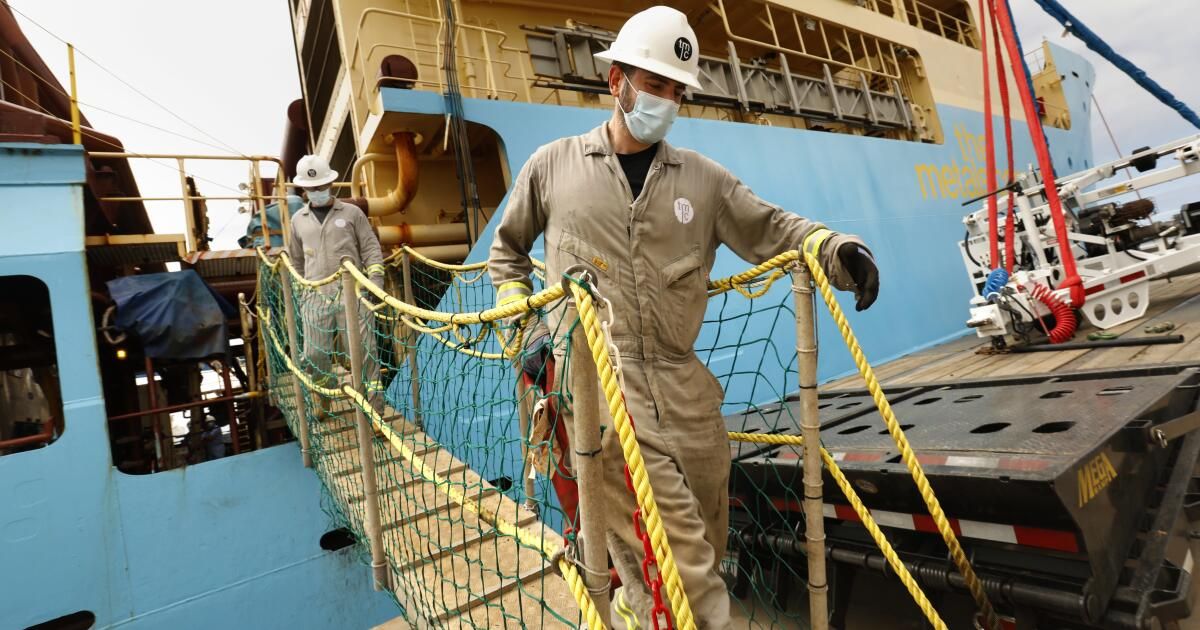As the global energy transition spurs demand for critical minerals, the International Seabed Authority has met in Jamaica to discuss the future of deep-sea mining and whether the industry can begin scraping the ocean floor for battery metals.
The debates come amid strong criticism from environmental groups, who say the risk of harming marine life is too great.
The proceedings are also being conducted without a vote by U.S. officials because the United States has not signed the United Nations Convention on the Law of the Sea, the international law that created the authority.
But that hasn't stopped California and other states from enacting their own bans and restrictions. Nor has it stopped a group of Democratic lawmakers from calling on President Biden to impose a moratorium on deep-sea mining.
“Seabed mining is unsafe and destructive,” said California Assemblywoman Luz Rivas (D-North Hollywood), who authored a 2022 bill banning the practice in state waters. “We shouldn’t be doing it anywhere, in any ocean, on any seabed.”
Aggressive and shocking reports on climate change, the environment, health and science.
But mining operations say the metals they plan to extract, such as cobalt and nickel, will help grow the green economy and avoid disruption to terrestrial habitats.
“The transition away from hydrocarbons is like day one, and we still have a long way to go,” said Gerard Barron, president of The Metals Company, a Canadian mining company that plans to extract metals in the Pacific’s Clarion-Clipperton Zone, a 4,500-mile stretch of ocean between Hawaii and Mexico.
“If you start looking at all the other forms of networked transportation and storage, and then look at the demand coming from industrialization in the developing world, if it's not grown, it's mined,” he said.
The fruit of these mining operations are polymetallic nodules, mineral spheres about the size of a baseball that are found far from shore, thousands of feet below the ocean surface.
Since state waters extend only three miles offshore, restrictions passed by California, Washington, Oregon and Hawaii are largely ineffective.
Still, opponents of deep-sea mining say the bans help send a message to the international community that “a sizable and powerful contingent” of the U.S. population opposes the practice, according to Hawaii state Sen. Chris Lee, a Democrat.
Additionally, a dozen Democratic lawmakers, including Reps. Sydney Kai Kamlager-Dove, Zoe Lofgren and Jared Huffman of California, Rep. Ed Case of Hawaii and Rep. Raul Grijalva of Arizona, have called on Biden to impose a moratorium on deep-sea mining in federal waters. They say too little is known about the environmental impacts to justify moving forward with mining.
Barron and other mining advocates insist that deep-sea extraction causes far less environmental and social disruption than mining on land. He said it can be done on the seabed or “underneath the equatorial rainforests. And that means that to get access to them, you have to remove the indigenous people who live there. You have to remove the rainforest, dig up the topsoil to get to the nickel-bearing mineral. And that’s just the beginning of the impacts, because then there’s waste.”
Lee, the Hawaii lawmaker, said the push to begin mining was premature and “frustrating,” especially as battery and magnet technologies are evolving toward using more affordable and abundant materials, such as sodium.
He argues that there are other options — including recycling and repair laws — that would allow these materials to be collected in ways that do not involve mining or the destruction of ecosystems and habitats.
That’s why he’s working to create and support laws that not only provide incentives for recycling but also create barriers for the deep-sea mining industry. In 2023, he helped pass a law that “basically gives our Department of Transportation authorization to block the use of our ports by any vessel that is conducting deep-sea mining activities,” he said.
Last December, a TMC ship scheduled to dock in Honolulu Harbor was turned away as protesters (Native Hawaiians, boaters and environmentalists) gathered to voice their discontent.
Lee said his law did not apply during this event because the ship turned of its own volition, but it does provide a deterrent.
Barron acknowledged resistance from state lawmakers and Native Hawaiians, saying he had met with some of the “elders,” had “listened to their thoughts,” but “there are a lot of niche groups that have a lot of ideas, right?”
He noted that his company is sponsored by the Pacific island nations of Nauru, Kiribati and Tonga, “nations that have been severely affected by climate change… and exploited for their natural resources,” and that they seek to benefit from his company’s industry “through jobs, royalties and some economic opportunities.”
His company needed the sponsorship of a sovereign nation in order to apply for a license from the international governing body to mine the ocean floor.
The Jamaica-based authority is currently deciding whether and how to allow deep-sea mining as more and more countries have expressed concerns. More than two dozen countries have called for a ban, suspension or moratorium on deep-sea mining.
The authority, which is the world's guardian of international deepwater, has awarded 31 mining exploration contracts but has not authorised any exploitation while the debate continues. TMC has threatened to seek permission before rules and regulations for deepwater mining are set.
Barron said that despite the concerns of Lee and others, his company is concerned about the environment and has sponsored and conducted studies showing that its harvesting activities will cause only minimal disturbance. He referred a reporter to work from MIT that showed that sediment plumes (or underwater dust clouds) caused by its excavating machinery travel only a few meters and remain relatively localized.
He said the result of driving over the sea floor with giant rakes and vacuum cleaners won't really make much of a difference to deep ocean habitat.
“There are several different types of habitats — all of them ubiquitous,” he said. “And what we’re going to do is basically convert a nodule-rich habitat into one that doesn’t have as many nodules. But both of those habitats are ubiquitous. So it’s just a matter of transforming one into the other and then providing the ability” for the disturbed habitat to “recolonize.”
Research has shown that at the depths where these nodules are found — between 9,000 and 12,000 feet below the surface — the darkness and pressure make recolonization by life a very slow process.
“Life moves at a much, much slower pace down there,” said Douglas McCauley, an associate professor in the Department of Ecology, Evolution and Marine Biology at UC Santa Barbara. “The oldest organism we know of on the planet lives in these ecosystems. It’s a black coral. Some of the specimens that scientists have collected and dated were actually born when people were building the pyramids.”
Barron said that as his machines have advanced, they have allowed the ecosystem to “thrive.”
“If you think about the life that’s down there, measured in grams per square meter, there’s about 10 grams of biomass … and 80% of that biomass is bacteria,” he said. “So, if you’re a sessile organism that’s sitting on a nodule and we harvest it, then that’s probably the end of life. But for bacteria, you know, what our studies are showing is that there can actually be a net positive impact … a bit like tilling the soil.”
He said their work, which is unpublished, shows that when they retested the areas they had cut 12 months earlier, they found the biomass was “thriving.”
Asked how they could tell that bacteria and other organisms were thriving, he said, “They're there. They're alive and… if they weren't… they would look different…”
McCauley said he could not comment on these observations because the work has not been published, but he noted a variety of organisms that have been discovered at these depths: “glassy sponges that look like they came straight out of a Tiffany brochure; ghostly white 'Casper' octopuses that have more YouTube views than I will ever have; and gummy squirrels.”
He also stressed that little is known about how animals such as beaked whales and squid use this ecosystem.
“The impacts that keep me up at night in ocean mining are those associated with the plumes of mining wastewater that would be created in the middle of the sea,” he said. “Giant, shifting hives that could smother the best tuna fishing grounds in the Pacific, the largest daily migration of life on the planet from the depths to the surface through the ocean’s twilight zone, a region that contains the most abundant vertebrate life on the planet and is traversed by whales, sea turtles and giant squid.”
He added that research shows that deep-sea mining “may become the noisiest activity ever undertaken in the ocean and a massive source of noise pollution.”












